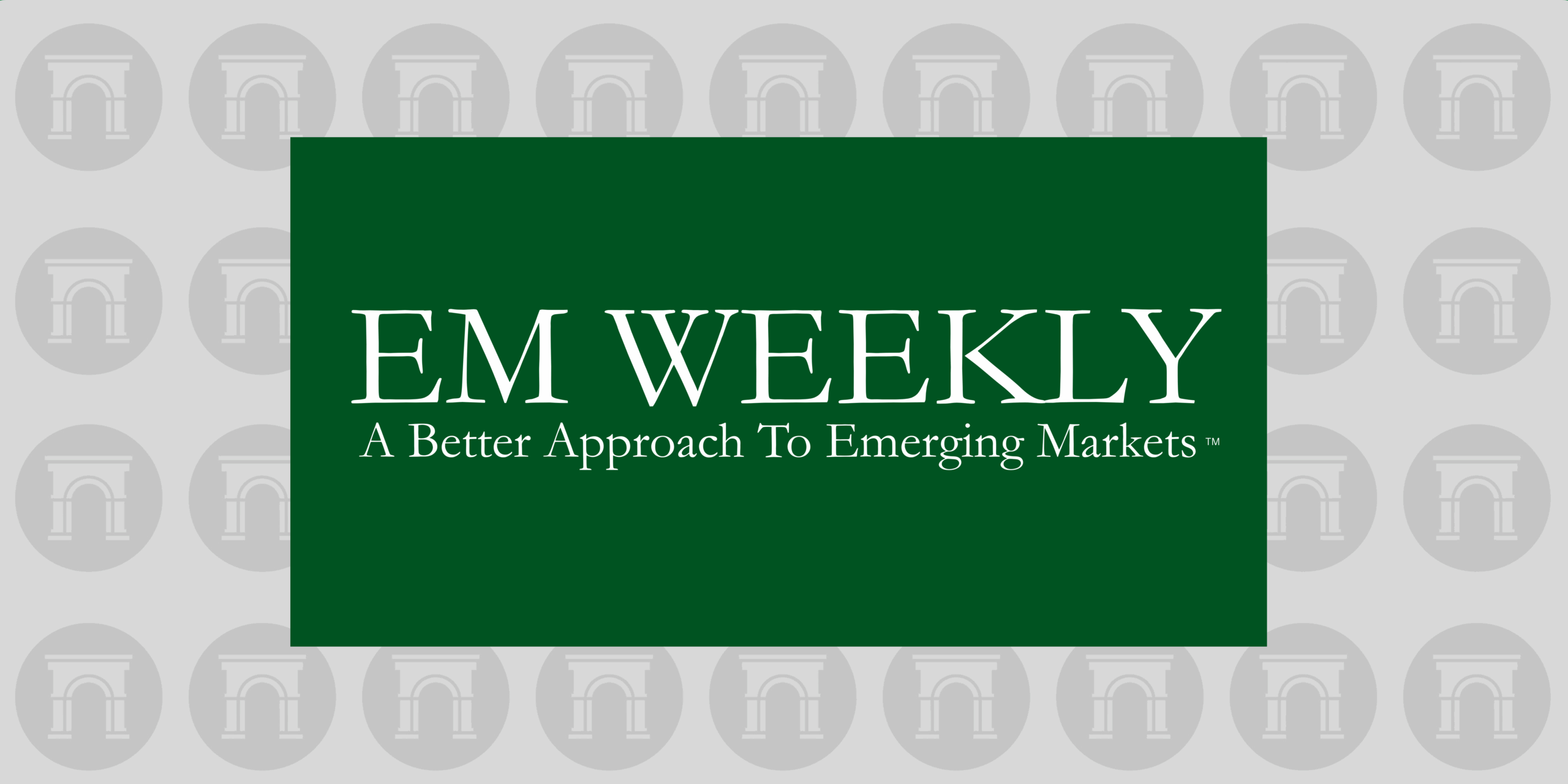Contents
Market Overview
Macro Update
This week saw more trade whiplash, with a significant ruling by the U.S. Court of International Trade deeming many of the White House’s “Liberation Day” tariffs illegal. On Friday, the ruling was temporarily stayed by the federal circuit court, and the administration has already signalled it will appeal the decision, potentially taking the issue all the way to the Supreme Court. The back and forth has added another layer of uncertainty to U.S. economic policy, and while markets initially welcomed the ruling as a check on further tariff escalation, its legal uncertainty and political friction may weigh on investor sentiment in the months ahead.
The rulings followed more trade tensions earlier in the week, when President Donald Trump threatened additional tariffs—including a 50% duty on all EU imports and a 25% levy on iPhones manufactured outside the U.S. These threats were later softened following what the President described as a constructive call with European Commission President Ursula von der Leyen, and the implementation deadline was pushed to July.
Market reaction was relatively muted. U.S. equity indexes closed the week mixed, mirroring similarly subdued performances across Asia and Europe. Treasury yields moved modestly lower, with the 10-year and 30-year notes ending just below 4.50% and 5.00%, respectively. This shift coincided with updated GDP data showing that the U.S. economy contracted at an annualized rate of 0.2% in the first quarter, slightly better than the initial -0.3% estimate, though still pointing to softening domestic demand and lower federal spending.
In currency markets, the dollar surrendered early week gains to fall below the 100 mark on the DXY, while the euro approached levels near its April high, of around 1.15 vs. the USD. Gold benefited from renewed uncertainty and regained ground, while oil prices came under pressure—Brent sliding to around $64 per barrel and WTI to roughly $60—amid speculation about a potential further increase in OPEC+ production.
On the monetary policy front, the minutes from the Federal Reserve’s early May meeting underscored a preference for caution. Officials acknowledged heightened uncertainty stemming from trade, fiscal, and regulatory developments, and highlighted the risk of both inflation and economic slowdown—an increasingly relevant combination in this tariff-influenced environment. The Fed’s emphasis on optionality reflects the complexity of current conditions, where conflicting signals make it difficult to chart a clear policy path.
Meanwhile, U.S. economic data this week painted a mixed picture. Durable goods orders declined 6.3% in April, less than the expected drop of 7.8%, following a strong upward revision for March to 7.6%. Consumer sentiment rebounded, with the Conference Board’s index rising sharply to 98 from 85.7 the previous month, offering some reassurance about household outlooks. However, initial jobless claims rose to 240,000, which is above both the prior week’s reading and consensus estimates. Real personal spending in April dropped to +0.1% month-over-month from +0.7% a month earlier, signalling that U.S. consumers slowed spending following the Liberation Day announcement. The Fed’s preferred price metric, the core personal consumption expenditure (Core PCE) index, remained tame, increasing 0.1% month-over-month and 2.5% year-over-year, down from 2.7% year-over-year in March. Data showed that prices rose modestly in categories with heavy exposure to China. The final May University of Michigan consumer sentiment index was unchanged from April at 52.2, slightly better than the preliminary reading (50.8) and median consensus expectations (51.5). However, it remains well below the January reading of 71.7. One year inflation expectations dropped to 6.6% year-over-year, from 7.3% year-over-year last month, but remain at the highest level in decades.
In Europe, relatively benign inflation readings in the largest economies could add further momentum to the case for a rate cut by the ECB in June. Inflation data from France showed headline CPI slowing more than expected, falling to 0.6% year-over-year in May—the lowest level since 2020 and well below the ECB’s 2% target. German CPI came in marginally above expectations: 0.2% vs. 0.1% month-over-month and 2.1% vs. 2.0% year-over-year in the May preliminary reading. However, it slowed down from 0.5% and 2.2%, respectively, in April.
Tensions on the geopolitical front also escalated. President Trump suggested Russia could face harsher consequences if drone strikes against Ukraine continue, although no concrete steps have followed. Meanwhile, German Chancellor Friedrich Merz lifted restrictions on Ukraine’s use of long-range missiles provided by European allies, potentially allowing Kyiv to strike deeper into Russian territory. President Volodymyr Zelenskiy, in turn, warned of a large Russian troop buildup that may signal a summer offensive.
On the corporate earnings front, Nvidia reported results that significantly beat expectations and delivered an encouraging outlook, despite continued export restrictions on its H20 chips to China. The company’s performance gave markets a modest lift and underscored the divergence between broad macroeconomic challenges and the strength of select corporate leaders.
EM Credit Update
Emerging market (EM) hard currency sovereign debt posted a gain of 0.5% for the week, led by the investment grade segment, which returned 0.7%. This outperformed EM high yield sovereigns, which rose just 0.4%. This outperformance occurred despite relatively stable U.S. Treasury yields, with sovereign spreads largely unchanged.
Once again, Africa was a key contributor to sovereign returns, with Angola, Ghana, and Kenya delivering notable outperformance. In contrast, Venezuela lagged, as new OFAC restrictions are expected to weigh heavily on already fragile economic activity. Ecuador also underperformed, following a fire at a major refinery, which is likely to increase pressure on the government’s fuel subsidy bill.
EM local currency sovereign debt returned to positive territory this week, gaining 0.3%, supported by renewed weakness in the U.S. dollar. Year-to-date, this segment remains a standout performer, returning 9.6%.
EM corporates trailed sovereigns slightly, delivering a 0.3% return at the index level, with broadly similar performance across both investment-grade and high-yield segments. Spreads remained stable, and market activity was relatively muted.
Primary issuance was subdued amid the shorter trading week. Nonetheless, a rare event occurred in the sovereign space with Kyrgyzstan debuting a $700 million, 5-year bond priced at 7.75%. On the corporate side, seven new deals priced, including a notable $5 billion triple-tranche issuance from Saudi Aramco.
The Week Ahead
Next week’s notable events include the final round of Poland’s presidential election in which Nationalist Karol Nawrocki faces liberal Warsaw Mayor Rafal Trzaskowski. In South Korea, presidential elections will be held to replace Yoon Suk Yeol, ousted after imposing military rule, and in Mexico, there will be elections for federal judges as part of the country’s judicial overhaul.
In the U.S., the Senate returns from its break and the Republicans will continue working out a Senate version of the House-passed tax and spending package. Markets will scrutinize the monthly U.S. employment report for May; preliminary forecasts point to a gain of 130,000 jobs, which would be below April’s total. The U.S. economy will also report ISM manufacturing, job openings, factory orders, light vehicle sales, consumer credit, trade data, and initial jobless claims.
In the realm of monetary policy, the European Central Bank, Bank of Canada, and Reserve Bank of India are all expected to ease by 25 bps. There will be rate decisions in Poland, Ukraine, and Russia as well. The week also offers PMI data from China, the eurozone, France, Germany, and India, while Indonesia, Pakistan, the eurozone, Czech Republic, South Korea, the Philippines, Taiwan, Thailand, Chile, and Vietnam report CPI for May. 1Q GDP numbers will be released by Poland, Serbia, Switzerland, Hungary, South Africa, Australia, South Korea, Ireland, Bulgaria, the eurozone, and Greece.
Fixed Income
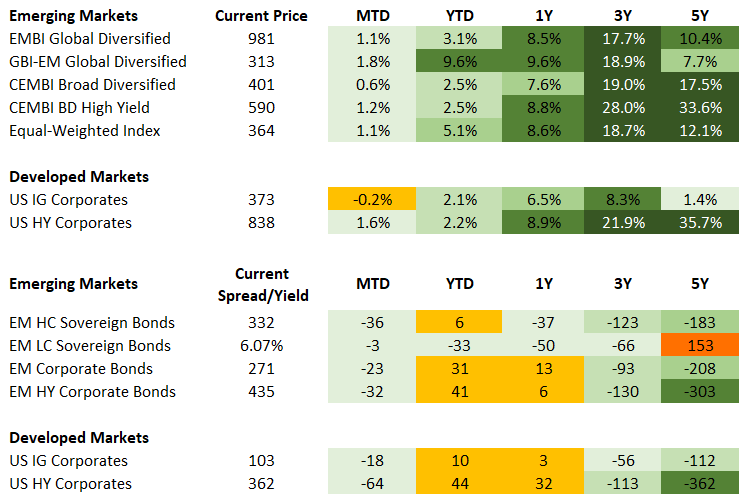
Equities
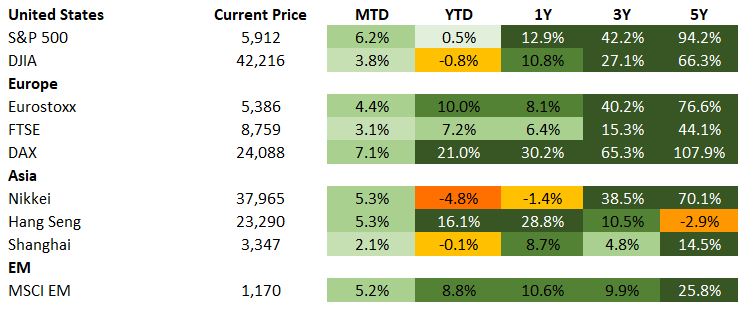
Commodities

Source for data tables: Bloomberg, JPMorgan, Gramercy. EM Fixed Income is represented by the following JPMorgan Indicies: EMBI Global, GBI-EM Global Diversified, CEMBI Broad Diversified and CEMBI Broad High Yield. DM Fixed Income is represented by the JPMorgan JULI Total Return Index and Domestic High Yield Index. Fixed Income, Equity and Commodity data is as of May 30, 2025 (mid-day).
Highlights
Turkish President Targets Comprehensive Constitutional Reform
Event: President Recep Tayyip Erdogan announced the appointment of ten legal experts who have started drafting a proposal on a new constitution for Türkiye.
Gramercy Comment: An amended or a new constitution could be one of the avenues President Erdogan uses to run for re-election in 2028 and retain power. Under the current constitutional framework, Erdogan is prevented from running again due to Türkiye’s existing limit of two five-year terms. Another scenario that could allow Erdogan to run again would involve the calling of early elections sometime in the second half of 2027, a few months before the end of his current mandate. This could allow him to claim he did not complete his term. However, this strategy carries some political risk and could be open to legal and constitutional challenges.
As such, the constitutional change path seems preferable from Erdogan’s perspective but is likely to be politically challenging. His AKP-MHP parliamentary coalition controls 320 seats but needs 360 for constitutional amendments via a public referendum. This gives significant leverage to the pro-Kurdish DEM party, considering its 56 seats in the National Assembly, but could also introduce internal tensions in the ruling coalition due to the ultra-nationalist tendencies of President’s Erdogan traditional political partner, the NHP party. To avoid going to the polls in a constitutional referendum, Erdogan needs a super majority (two-thirds) of 400 votes in the 600-seat legislature, a political feat that would require unprecedented alliance building across ideological lines and appears unlikely.
Against this backdrop, continued political support for Turkish Finance Minister Mehmet Simsek’s credit-positive macroeconomic adjustment program, and Mr. Simsek’s relative strength within the government, hinges on Erdogan’s domestic popularity. This is a key metric we will follow in the coming months.
Romanian and Polish Elections in Focus
Event: Romania’s second round of presidential elections was held on May 18th. Independent candidate Nicusor Dan defeated far-right contender George Simion with 43% and 46% of the vote, respectively, and was sworn in on May 26th. His first task is government formation, followed by swift fiscal consolidation measures.
Poland held its first round presidential vote on May 18th, which delivered a close outcome. Ruling party candidate Mr. Trzaskowski obtained 31.4% of the vote compared to 29.5% for right-wing backed candidate Mr. Nawrocki. The second round will be held on June 1st where polls point to another tight race in marginal favor of Mr. Trzaskowski.
Gramercy Comment: In Romania, the Dan victory was seen as a better market outcome than a Simion win, given expectations for a comparatively smoother path to government formation and better EU relations. This is expected to drive a partial retracing of the weakness that occurred in the aftermath of the first round, when Mr. Simion obtained the greatest share of votes. The composition of the new coalition will be an important driver for political stability and Romania’s ability to deliver fiscal measures to secure EU funds and avoid a rating downgrade.
In Poland, the market expects a status-quo Trzaskowski win. A Nawrocki win could generate moderate market volatility and legislative headwinds given that the current coalition is shy of the 60% needed in the lower house to overturn a presidential veto.
Guatemala Positive Rating Momentum on Economic Resiliency
Event: S&P lifted its rating of Guatemala by one notch, to BB+, with a stable outlook on the country’s conservative macroeconomic policies, low debt, and strong external and fiscal buffers. This aligns S&P with Moody’s, while Fitch placed its BB rating on positive outlook in February.
Gramercy Comment: We expect continued positive rating momentum with an eventual upgrade from Fitch, although we do not expect ratings to reach investment grade in the near term. With the current external backdrop, Guatemala benefits from ample fiscal flexibility for counter-cyclical policy and moderate trade exposure to the U.S. While remittances from the U.S. are significant, and could face eventual headwinds from the currently proposed tax as well as slower U.S. growth, front-loading of the remittance flows is likely to provide a boon in 1H.
Emerging Markets Technicals
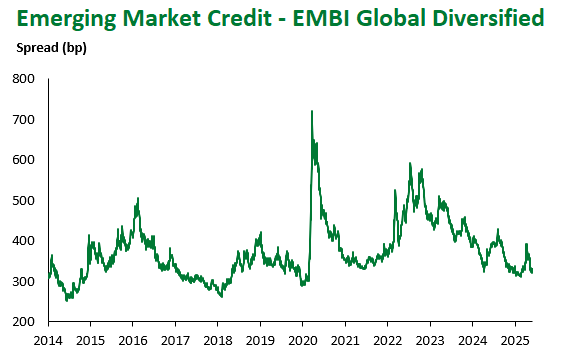
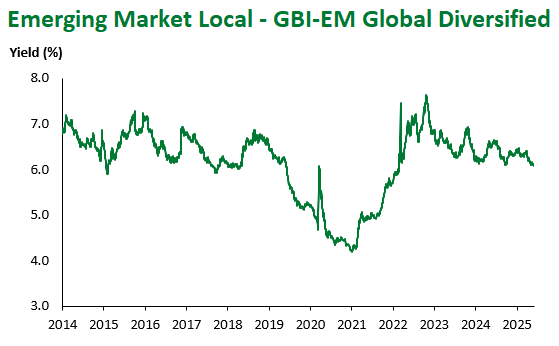

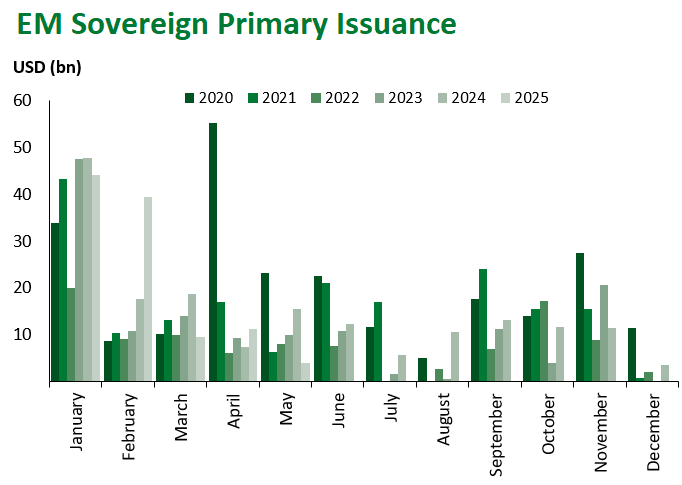
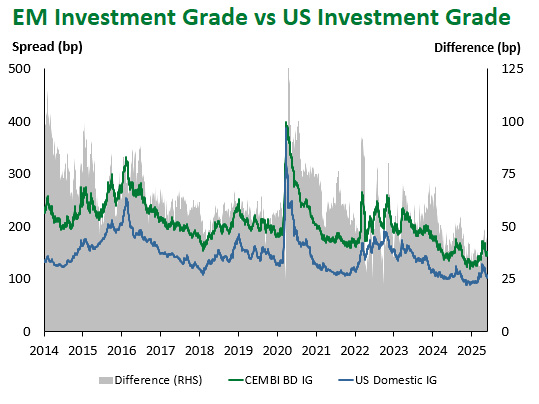
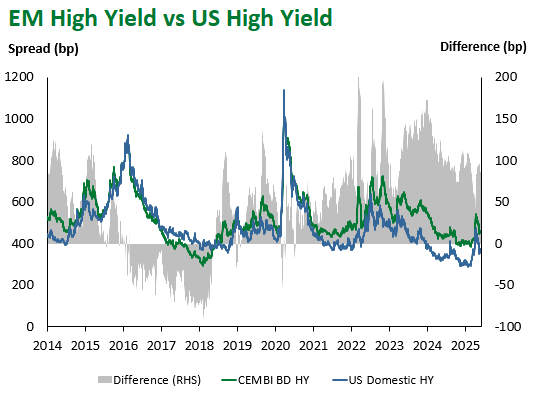

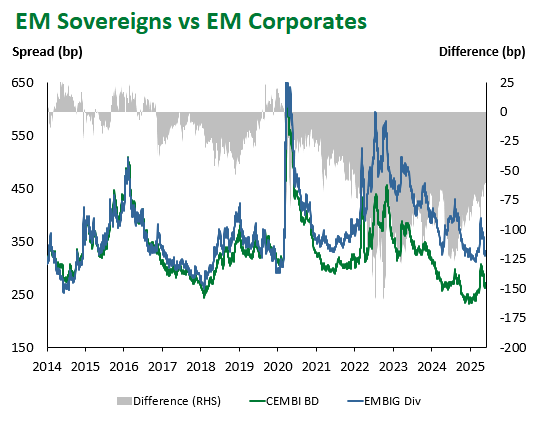
Emerging Markets Flows

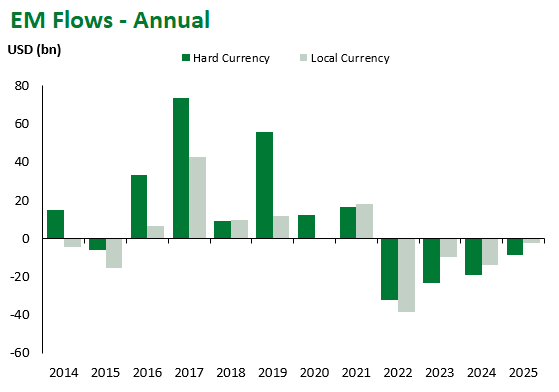
Source for graphs: Bloomberg, JPMorgan, Gramercy. As of May 30, 2025.
For questions, please contact:
Kathryn Exum, CFA ESG, Director, Co-Head of Sovereign Research, [email protected]
Petar Atanasov, Director, Co-Head of Sovereign Research, [email protected]
This document is for informational purposes only. The information presented is not intended to be relied upon as a forecast, research or investment advice, and is not a recommendation, offer or solicitation to buy or sell any securities or to adopt any investment strategy. Gramercy may have current investment positions in the securities or sovereigns mentioned above. The information and opinions contained in this paper are as of the date of initial publication, derived from proprietary and nonproprietary sources deemed by Gramercy to be reliable, are not necessarily all-inclusive and are not guaranteed as to accuracy. This paper may contain “forward-looking” information that is not purely historical in nature. Such information may include, among other things, projections and forecasts. There is no guarantee that any forecasts made will come to pass. Reliance upon information in this paper is at the sole discretion of the reader. You should not rely on this presentation as the basis upon which to make an investment decision. Investment involves risk. There can be no assurance that investment objectives will be achieved. Investors must be prepared to bear the risk of a total loss of their investment. These risks are often heightened for investments in emerging/developing markets or smaller capital markets. International investing involves risks, including risks related to foreign currency, limited liquidity, less government regulation, and the possibility of substantial volatility due to adverse political, economic or other developments. References to any indices are for informational and general comparative purposes only. The performance data of various indices mentioned in this update are updated and released on a periodic basis before finalization. The performance data of various indices presented herein was current as of the date of the presentation. Please refer to data returns of the separate indices if you desire additional or updated information. Indices are unmanaged, and their performance results do not reflect the impact of fees, expenses, or taxes that may be incurred through an investment with Gramercy. Returns for indices assume dividend reinvestment. An investment cannot be made directly in an index. Accordingly, comparing results shown to those of such indices may be of limited use. The information provided herein is neither tax nor legal advice. Investors should speak to their tax professional for specific information regarding their tax situation.
